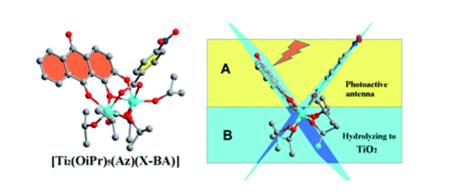Effectsofco-coordinated auxiliaryligandsonthe photoelectrochemicalbehaviour oftitanium- alkoxide-dyes†
YaoGuo,Jin-LeHou,WenLuo,Zhao-QiLi,Dan-HongZou,Qin-YuZhu*(朱琴玉)andJieDai*(戴洁)
College of Chemistry, Chemical Engineering and Materials Science, Soochow University, Suzhou 215123, People's Republic of China
J. Mater. Chem. A, 2017, 5, 18270--18275
We have reported that dyes with a titanium alkoxide moiety can improve dye-semiconductor surface properties, such as anchoring and molecular distribution. Here, we report three new titanium-alkoxide-dyes (TADs): [Ti2(OiPr)5(Az)(NO2-BA)] (1), [Ti2(OiPr)5(Az)(F-BA)] (2), [Ti2(OiPr)5(Az)(Br-BA)] (3) (H2Az = alizarin dye and HBA = benzoic acid), in which the titanium alkoxide clusters are coordinated with alizarin dye and an auxiliary ligand, namely a benzoic acid substituted with –NO2, –F or –Br. Their photo-absorption was greatly shifted to lower energy, due to the charge transfer from the π-conjugated dye moiety to Ti(IV). The structures of all these compounds could be divided into two functional parts: a conjugated organic photosensitive antenna part and a hydrolyzable anchoring part. Using 1–3 as new sensitive dyes, dye-sensitized TiO2 electrodes were prepared for measurement of the photocurrent response in an I2/I3− solution cell. In comparison with the organic dye-treated TiO2 electrode, considerable improvement in photocurrent density was observed for the TAD-treated TiO2 electrodes. The effect of different substituted auxiliary ligands on the photocurrent conversion was evaluated. Their photocurrent density was in the order NO2 > F > Br, which was in accordance with the electron-withdrawing property of the substituted groups. This work not only demonstrated the advantages of TADs but also showed, for the first time, the effect of electron-withdrawing auxiliary ligands.

链接:http://pubs.rsc.org/en/content/articlelanding/2017/ta/c7ta05639g#!divAbstract